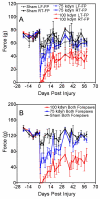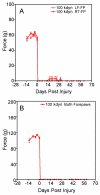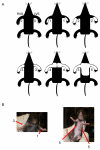A bilateral cervical contusion injury model in mice: assessment of gripping strength as a measure of forelimb motor function
- PMID: 19815010
- PMCID: PMC2812629
- DOI: 10.1016/j.expneurol.2009.09.028
A bilateral cervical contusion injury model in mice: assessment of gripping strength as a measure of forelimb motor function
Abstract
Here, we describe a bilateral cervical contusion model for mice. Adult female mice received graded bilateral contusion injuries at cervical level 5 (C5) using a commercially available impactor (the IH device). Three separate experiments were carried out to define conditions that produce impairments in forelimb function without unacceptable impairment of general health. A grip strength meter (GSM) was used to assess gripping ability as a measure of forelimb motor function; lesion size was assessed histologically by staining cross sections for H&E and GFAP. In Experiment 1, mice received injuries of 30 kilodynes (kdyn); these produced minimal deficits on grip strength. In Experiment 2, mice received injuries of 75 kdyn and 100 kdyn. Injuries of 75 kdyn produced transient deficits in gripping that recovered between 3 and 15 days post-injury (dpi) to about 90% of control; injuries of 100 kdyn produced deficits that recovered to about 50% of control. In Experiment 3, none of the mice that received injuries of 100 kdyn recovered gripping ability. Histological assessment revealed graded injuries that ranged from damage limited primarily to the dorsal column (DC) to damage to the DC, grey matter, ventral column and lateral column. Most lesions filled in with a fibrous tissue matrix, but fluid-filled cystic cavities were found in 13% of the 100 kdyn injury group and a combination of fibrous-filled/fluid-filled cystic cavities were found in 22% and 38% of the 75-kdyn and 100-kdyn injury groups, respectively. There was minimal urine retention following cervical contusion injuries indicating preservation of bladder function. Our results define conditions to produce graded bilateral cervical contusion injuries in mice and demonstrate the usefulness of the GSM for assessing forelimb motor function after cervical contusions.
Figures












References
-
- One degree of separation: Paralysis and spinal cord injury in the United States. Christopher and Dana Reeve Foundation; 2009. pp. 1–24.
-
- Anderson KD. Targeting recovery: priorities of the spinal cord-injured population. J Neurotrauma. 2004;21:1371–1383. - PubMed
-
- Anderson KD, Abdul M, Steward O. Quantitative assessment of deficits and recovery of forelimb motor function after cervical spinal cord injury in mice. Exp Neurol. 2004;190:184–191. - PubMed
-
- Basso DM, Fisher LC, Anderson AJ, Jakeman LB, McTigue DM, Popovich PG. Basso Mouse Scale for locomotion detects differences in recovery after spinal cord injury in five common mouse strains. J Neurotrauma. 2006;23:635–659. - PubMed
Publication types
MeSH terms
Substances
Grants and funding
LinkOut - more resources
Full Text Sources
Medical
Miscellaneous
